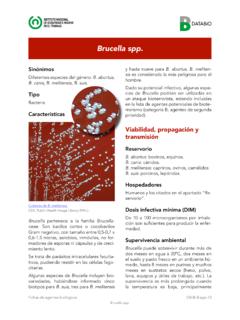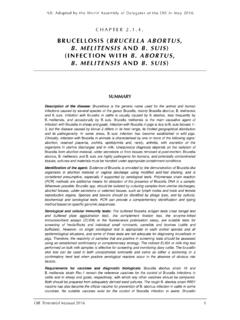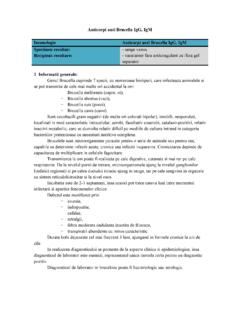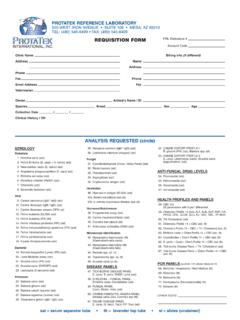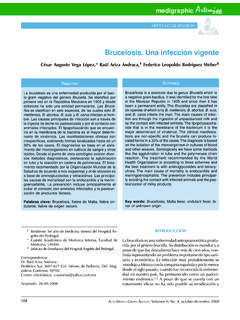Transcription of Section VIII—Agent Summary Statements
1 agent Summary Statements : Bacterial Agents 123 Section viii agent Summary StatementsSection viii -A: Bacterial AgentsBacillus anthracisBacillus anthracis, a gram-positive, non-hemolytic, and non-motile bacillus, is the etiologic agent of anthrax, an acute bacterial disease of mammals, including humans. Like all members of the genus Bacillus, under adverse conditions B. anthracis has the ability to produce spores that allow the organism to persist for long periods until the return of more favorable conditions. Reports of suspected anthrax outbreaks date back to as early as 1250 BC. The study of anthrax and B. anthracis in the 1800s contributed greatly to our general understanding of infectious diseases. Much of Koch s postulates were derived from work on identifying the etiologic agent of anthrax. Louis Pasteur developed the first attenuated live vaccine for mammals are susceptible to anthrax; it mostly affects herbivores that ingest spores from contaminated soil and, to a lesser extent, carnivores that scavenge on the carcasses of diseased animals.
2 Anthrax still occurs frequently in parts of central Asia and Africa. In the United States, it occurs sporadically in animals in parts of the West, Midwest and infectious dose varies greatly from species to species and is route-dependent. The inhalation anthrax infectious dose (ID) for humans primarily has been extrapolated from inhalation challenges of nonhuman primates (NHP) or studies done in contaminated mills. Estimates vary greatly but the medium lethal dose (LD50) is likely within the range of 2,500-55,000 It is believed that very few spores (10 or less) are required for cutaneous InfectionsOccupational infections are possible when in contact with contaminated animals, animal products or pure cultures of B. anthracis, and may include ranchers, veterinarians and laboratory workers. Numerous cases of laboratory-associated anthrax (primarily cutaneous) have been ,4 Recent cases include suspected cutaneous anthrax in a laboratory worker in Texas and a cutaneous case in a North Dakota male who disposed of five cows that died of ,6 Natural Modes of InfectionThe clinical forms of anthrax in humans that result from different routes of infection are: 1) cutaneous (via broken skin); 2) gastrointestinal (via ingestion); and 3) inhalation anthrax.
3 Cutaneous anthrax is the most common and readily treatable form of the disease. Inhalation anthrax used to be known as Woolsorter disease due to its prevalence in textile mill workers handling wool and other contaminated animal products. While naturally occurring disease is no longer a 124 Biosafety in Microbiological and Biomedical Laboratoriessignificant public health problem in the United States, anthrax has become a bioterrorism concern. In 2001, 22 people were diagnosed with anthrax acquired from spores sent through the mail, including 11 cases of inhalation anthrax with five deaths and 11 cutaneous Safety and Containment RecommendationsB. anthracis may be present in blood, skin lesion exudates, cerebrospinal fluid, pleural fluid, sputum, and rarely, in urine and feces. The primary hazards to laboratory personnel are: direct and indirect contact of broken skin with cultures and contaminated laboratory surfaces, accidental parenteral inoculation and, rarely, exposure to infectious aerosols.
4 Efforts should be made to avoid production of aerosols by working with infectious organisms in a BSC. In addition, all centrifugation should be done using aerosol-tight rotors that are opened within the BSC after each practices, containment equipment, and facilities are recommended for activities using clinical materials and diagnostic quantities of infectious cultures. ABSL-2 practices, containment equipment and facilities are recommended for studies utilizing experimentally infected laboratory rodents. BSL-3 practices, containment equipment, and facilities are recommended for work involving production quantities or high concentrations of cultures, screening environmental samples (especially powders) from anthrax-contaminated locations, and for activities with a high potential for aerosol production. Workers who frequently centrifuge B.
5 Anthracis suspensions should use autoclavable aerosol-tight rotors. In addition, regular routine swabbing specimens for culture should be routinely obtained inside the rotor and rotor lid and, if contaminated, rotors should be autoclaved before IssuesVaccines A licensed vaccine for anthrax is available. Guidelines for its use in occupational settings are available from the ,9 Worker vaccination is recommended for activities that present an increased risk for repeated exposures to B. anthracis spores including: 1) work involving production quantities with a high potential for aerosol production; 2) handling environmental specimens, especially powders associated with anthrax investigations; 3) performing confirmatory testing for B. anthracis, with purified cultures; 4) making repeated entries into known B. anthracis-spore-contaminated areas after a terrorist attack; 5) work in other settings in which repeated exposure to aerosolized B.
6 Anthracis spores might occur. Vaccination is not recommended for workers involved in routine processing of clinical specimens or environmental swabs in general diagnostic agent B. anthracis is a select agent requiring registration with CDC and/or USDA for possession, use, storage and/or transfer. See Appendix F for additional information. agent Summary Statements : Bacterial Agents 125 Transfer of agent Importation of this agent may require CDC and/or USDA importation permits. Domestic transport of this agent may require a permit from USDA/APHIS/VS. A Department of Commerce (DoC) permit may be required for the export of this agent to another country. See Appendix C for additional pertussisBordetella pertussis, an exclusively human respiratory pathogen of worldwide distribution, is the etiologic agent of whooping cough or pertussis.
7 The organism is a fastidious, small gram-negative coccobacillus that requires highly specialized culture and transport media for cultivation in the laboratory. Its natural habitat is the human respiratory InfectionsOccupational transmission of pertussis has been reported, primarily among healthcare Outbreaks, including secondary transmission, among workers have been documented in hospitals, long-term care institutions, and laboratories. Nosocomial transmissions have been reported in healthcare settings. Laboratory-acquired pertussis has been ,18 Natural Modes of InfectionPertussis is highly communicable, with person-to-person transmission occurring via aerosolized respiratory secretions containing the organism. The attack rate among susceptible hosts is affected by the frequency, proximity, and time of exposure to infected individuals.
8 Although the number of reported pertussis cases declined by over 99% following the introduction of vaccination programs in the 1940s, the 3- to 4-year cycles of cases have continued into the post-vaccination Safety and Containment RecommendationsThe agent may be present in high levels in respiratory secretions, and may be found in other clinical material, such as blood and lung tissue in its infrequent manifestation of septicemia and pneumonia, ,23 Because the natural mode of transmission is via the respiratory route, aerosol generation during the manipulation of cultures and contaminated clinical specimens generates the greatest potential practices, containment equipment, and facilities are recommended for all activities involving the use or manipulation of known or potentially infectious clinical material and cultures.
9 ABSL-2 practices and containment equipment should be employed for housing experimentally infected animals. Primary containment devices and equipment, including biological safety cabinets, safety centrifuge cups or safety centrifuges should be used for activities likely to 126 Biosafety in Microbiological and Biomedical Laboratoriesgenerate potentially infectious aerosols. BSL-3 practices, containment equipment, and facilities are appropriate for production IssuesVaccines Pertussis vaccines are available but are not currently approved or recommended for use in persons over six years of age. Because this recommendation may change in the near future, the reader is advised to review the current recommendations of the ACIP published in the Morbidity and Mortality Weekly Report (MMWR) and at the CDC Vaccines and Immunizations Web site for the latest recommendations for adolescents and of agent Importation of this agent may require CDC and/or USDA importation permits.
10 Domestic transport of this agent may require a permit from USDA/APHIS/VS. A DoC permit may be required for the export of this agent to another country. See Appendix C for additional speciesThe genus brucella consists of slow-growing, very small gram-negative coccobacilli whose natural hosts are mammals. Seven brucella species have been described using epidemiologic and biological characteristics, although at the genetic level all brucellae are closely related. B. melitensis (natural host: sheep/goats), B suis (natural host: swine), B. abortus (natural host: cattle), B. canis (natural host: dogs), and B. maris (natural host: marine mammals) have caused illness in humans exposed to the organism including laboratory ,25 Hypersensitivity to brucella antigens is a potential but rare hazard to laboratory personnel. Occasional hypersensitivity reactions to brucella antigens occur in workers exposed to experimentally and naturally infected animals or their InfectionsBrucellosis has been one of the most frequently reported laboratory infections in the past and cases continue to ,26-28 Airborne and mucocutaneous exposures can produce LAI.











